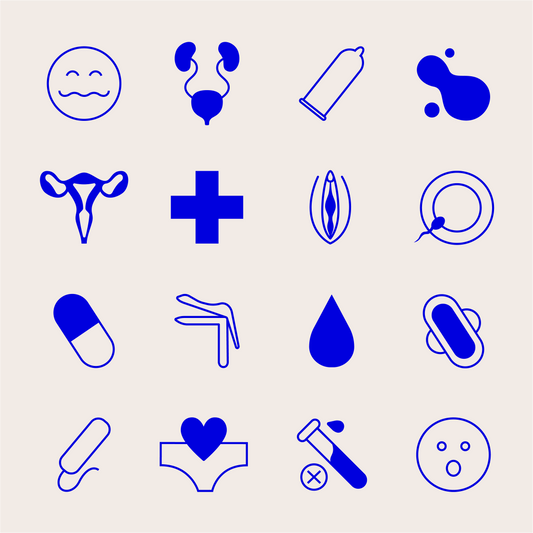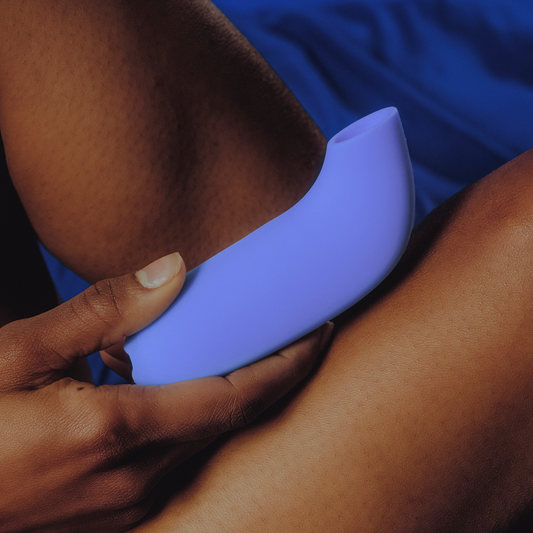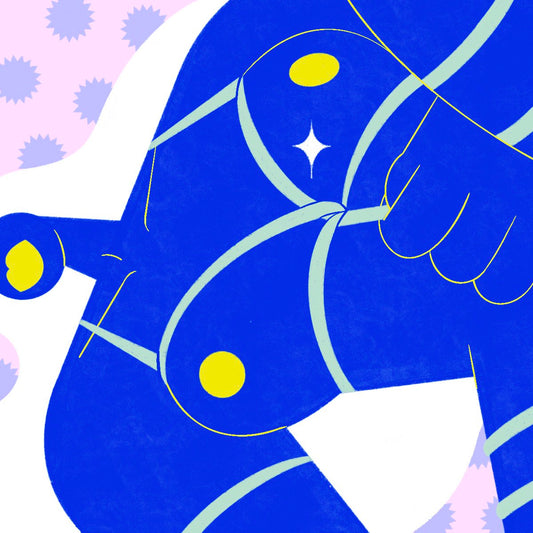Let’s start by addressing the obvious: Having multiple orgasms can be both really fun and really hot.
Or, multiple orgasms might be uncomfortable and leave your body feeling overwhelmed.
And…sometimes we feel both sets of feelings at the same time.
You’ve read it before, and I’ll say it again: All bodies are unique. Sometimes, when people ask me about pursuing multiple orgasms, they’re asking about it as if having multiple orgasms is like winning a gold medal in sex.
And just to say it…it’s not! Some people love having multiple orgasms and it’s their preferred way to cum. Others are completely satisfied with one. Neither is better or worse than the other, and many people are happy either way — it just depends on the context.
Exploring multiple orgasms can be fun and can teach you more about your body, but I caution against pursuing them out of a sense of pressure. If you’re feeling like you’re sexually “insufficient” or “unrealized” if you haven’t had multiple orgasms, take some of the pressure off yourself. Every person’s body is different.
If you’ve landed on this article but aren’t certain you’ve ever had an orgasm before (or know you haven’t), then check out these articles too:
- How to Tell If You’ve Had an Orgasm
- A Beginner’s Guide to Masturbation
- In Search of Your First Orgasm?
Orgasms are one of the many ways that we measure sexual pleasure and satisfaction, but they’re not the only way to measure your pleasure.
Still, many people are curious about multiple orgasms. They wonder if they’re really possible, if people with penises can have them or if they’re just for folks with vaginas, if they hurt, if they really feel good, and what happens once you’ve crossed the multiorgasmic threshold.
If you’re beginning your journey into multiorgasmic territory, you’ve come to the right place. Let’s dive in.
How many orgasms is it possible to have?
If you Google the record for the highest number of orgasms someone has had, you’ll find some potentially surprising information.
Article after article will tell you that “After studying orgasm for 22 years, William Hartman and Marilyn Fithian of the Centre for Marital and Sexual Studies in California reported a maximum [of] 134 per hour for a woman [compared to] 16 for a man.”
Let that sink in for a minute. One hundred and thirty-four orgasms in one hour. That’s a lot!
The 134 and 16 figures have been widely reported for more than 20 years, but the actual data from these studies has actually never been formally published. So, you won’t find the source journal articles for those figures, and probably never will — both Fithian and Hartman, the original researchers, have passed away.
But perhaps, one day, another intrepid research team will pick up the question of “how many orgasms can someone have?” and maybe we’ll get some confirmed data.
The refractory period: the time between you and your next O
When it comes to having multiple orgasms, there is one biological process that you have to be deeply familiar with: the refractory period.
The “refractory period” is a fancy way of saying the time in between an orgasm and when someone’s body is ready for sexual activity again. It’s that period of time where your blood pressure and heart rate lower, penises become flaccid, and blood flow returns to normal.
Refractory periods vary in length, and both people with vaginas and people with penises experience them. For people with penises, refractory periods vary quite a bit throughout the lifespan — they typically get longer as one gets older.
For people with vaginas, refractory periods can be pretty short (remember that person who experienced 134 orgasms in an hour? That’s 2.2 orgasms per minute.) Many people with vaginas describe multiple orgasms as being several small ones in a row, rather than a few big ones spaced apart. Orgasms feel different to each person!
Some people might be ready to go 90 seconds after having an orgasm, and others might need 90 minutes or longer.
During the refractory period, some people may not be sexually responsive at all, and others might feel super sensitive. Bodies are unique!
Many of the articles that you’ll ready about refractory periods refer to the penis’ ability to get erect, but I’m here to remind you that flaccid penises can experience pleasure, too.
Ultimately, know about how your body typically reacts during and after orgasm. Does it vary with different types of play? On your own or with partners? Do you need a decent amount of down time or are you ready for business almost immediately after?
Knowing how your body typically responds will bring you closer to multiorgasmic territory, because then you can tailor rounds two through infinity to meet your body’s changing needs.
Tips for Pursuing Multiple Orgasms
If you want to explore your body’s capacity for multiple orgasms, these tips will help you get started. Remember — everyone’s body is different, so your experience may vary. Always use your experience of pleasure as your primary guide!
1. Remember that context matters
When it comes to experiencing multiple orgasms, the context matters just as much as the technique. Some people are reliably multiorgasmic during masturbation sessions, but with partners are happily on team one-and-done.
Things like your age, stress level, frequency of sexual activity, and even where you are in your menstrual cycle can affect your body’s sexual response and readiness.
So, don’t bully your body into something it might not be up for that day! Pursuing multiple orgasms should be fun and pleasurable, not stressful.
2. Switch up types of stimulation
Creativity is truly the key to multiple orgasms. Often, when someone is pursuing multiple orgasms, switching up the types of stimulation for each orgasm can be helpful.
For example, after you’ve reached your first orgasm via your favorite technique, you might spend a long time stimulating your nipples. They’ll likely be pretty sensitive because they’ll still have heightened blood flow, and nipple stimulation can lead to heightened arousal — which can make your second orgasm come more easily.
Or, if you had your first orgasm from internal vaginal stimulation, you might opt for external clitoral play. Someone with a penis might opt for anal play (either internal or external) for round two.
Switching up the type of stimulation you use to pursue your second, third, fourth, or hundred and thirty-fourth orgasm will help keep your nerve endings from becoming overstimulated and feeling like they’re numbed out.
And just to say it, some people want the exact same type of stimulation over and over. That might be because they know that it’s the most reliable route to orgasm for them, or it could be part of kink play (for example — someone might be restrained and their partner holds a wand vibrator against their clitoris while they orgasm over and over again).
So, you do you, babe.
3. Use toys to your advantage
Say it with me: Sex toys are members of your team. They aren’t competing with your partners. They’re tools to help us access pleasure!
If you’re going for an extended, multiorgasmic romp, you’re probably going to experience some body fatigue. Whether you’re having a solo adventure or you’re playing with partners, bodies just get tired. Forearms shake, jaws lock up, and our core says we simply can’t thrust anymore.
It’s hard out there.
So, use toys to supplement your experience. You might use a butt plug that vibrates. Or, you might add nipple clamps to extend your pleasure, hands-free.
And a time-honored favorite? Your trusty vibrator. Versatile vibrators, like wands and bullets, can be used on both vulvas and penises. And because they do something that the human body simply cannot, they can help propel you to orgasm time and time again.
Other toys, like positioning aids, can help support your joints and relieve some unwanted pressure.
4. Plan out a multisensory experience
Not to be dramatic, but this is a hill I will die on. Sex is a multisensory experience — and too often, we get caught up on “must stimulate the genitals!!!” and forget the rest of it.
If you’re newly exploring multiorgasmic territory, thinking outside the “must stimulate the genitals!!!” box is essential. What other types of sensations bring you physical pleasure?
Maybe, after your first orgasm, you tease your body with a feather tickler or some wax play.
Engaging your senses is a great way to expand your body’s capacity (and desire) for multiple orgasms, because you’re pleasurably stimulating it during the refractory period, which can more quickly lead to heightened arousal. And just to say it, the keyword there was “pleasurably” stimulating your body. If stimulation hurts or feels uncomfortable (and not in a kinky, wanted way), then give your body a break.
You might also turn toward tools like audio erotica or porn to turn you on again.
5. Don’t assume — communicate
Because multiple orgasmics are often talked about like they’re a personal accomplishment, we might assume that our partners want to have more than one orgasm. But for some people, that intensity might not feel good! Or, they might really enjoy it one day, and not be interested in it the next.
To live a truly fulfilling and pleasurable sex life, open communication is essential. Talk with your partners ahead of time about what they’re interested in, check-in throughout about how they’re feeling and what they want, and once the clothes are back on, talk about what the experience was like.
Do they have a specific number they’re aiming for? If they’ve experienced multiple orgasms before, how do they know when they’re ready to tap out? When all is said and done, how do you each want to be cared for?
Open and compassionate communication is how we access truly pleasurable and fulfilling sexual experiences, regardless of how many orgasms show up to the party.
Exploring multiple orgasms can be a fun, surprising, and pleasurable pursuit. So take these tips and see what happens! (If we don’t hear from you, we’ll assume you’re still in orgasmic heaven.)


























